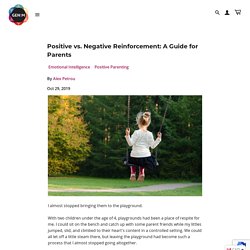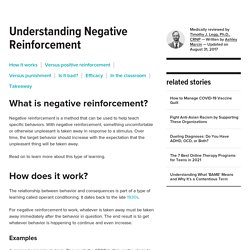

Positive vs. Negative Reinforcement: A Guide for Parents – Generation Mindful. I almost stopped bringing them to the playground.

With two children under the age of 4, playgrounds had been a place of respite for me. I could sit on the bench and catch up with some parent friends while my littles jumped, slid, and climbed to their heart's content in a controlled setting. We could all let off a little steam there, but leaving the playground had become such a process that I almost stopped going altogether.
Inevitably, when I announced it was time to go, my 3-year-old would run away. Reinforcement: What is this? Punishment: What is it? Operant Conditioning (B.F. Skinner) How Reinforcement and Punishment Modify Behavior Operant conditioning, also known as instrumental conditioning, is a method of learning normally attributed to B.F.
Skinner, where the consequences of a response determine the probability of it being repeated. Understanding teenagers: Understanding Adolescent Development Explained PDF. Discipline strategies for teenagers that parents can use - Reinforcement and Punishment. Teenage discipline: the basics Discipline isn’t about punishment.

It’s about teaching children appropriate ways to behave. Positive Reinforcement for Adolescents. By the time children have reached adolescence, their responses are often ingrained, but parental actions can still positively affect adolescent behavior. Since adolescents are struggling to develop their personal identity and are concerned about their body image, parental support is crucial to help positively frame experiences as learning opportunities. Positive reinforcement remains a powerful teaching tool during these formative years, and we encourage parents to take time to contemplate the ways they can help adolescents mature and become self-reliant.
Negative Reinforcement: What Is It and How Does It Work? What is negative reinforcement?

Negative reinforcement is a method that can be used to help teach specific behaviors. With negative reinforcement, something uncomfortable or otherwise unpleasant is taken away in response to a stimulus. Over time, the target behavior should increase with the expectation that the unpleasant thing will be taken away. Effective Consequences for Teenagers (Punishment) If you’re having trouble giving effective consequences to your teen, know that you are not alone.

Many parents tell me that nothing seems to work, and that coming up with the right thing for their child can seem like an impossible task. If you’re the parent of an adolescent, you may have grounded your child, taken away their video games, or suspended their driving privileges for months on end. But as James Lehman says, you can’t punish kids into acceptable behavior—it just doesn’t work that way. After reading through the articles...
On its own, positive punishment may not be a good long-term solution. It may be more effective when combined with positive and negative reinforcement. Positive punishment is a form of behavior modification.

In this case, the word “positive” doesn’t refer to something pleasant. Positive punishment is adding something to the mix that will result in an unpleasant consequence. No. Reasoning: References: